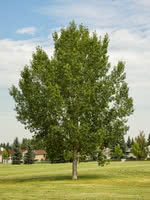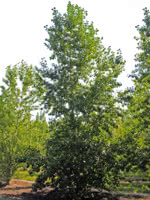Mon-Fri 9am - 5pm Mountain time
Northwest Poplar vs Tristis Poplar
Populus x jackii Northwest
Populus x Tristis
NOT AVAILABLE THIS SEASON - MIGHT RETURN
Northwest Poplar is a large and fast-growing tree. Due to its wide spread, this tree makes a great shade or shelterbelt tree. Northwest Poplar tolerates partial shade, drought, and most types of soil. This poplar produces no fuzz.
Northwest Poplar continues to be popular as a shelterbelt species due to the great cost savings that come from the wide spread of the branches. It is a staff favorite because of the wonderful shade it provides all summer long.
Tristis Poplar is a large deciduous tree. It is cold hardy, disease resistant, and relatively drought tolerant. Tristis Poplar loses its leaves later in the year than other Poplars, making it a great ornamental tree in fall.
It's known for its strongly scented balsamic buds and yellow foliage in autumn. Because of its size, Tristis Poplar is most suitable for large properties and will help prevent wind erosion.
Tristis Poplar is slower-growing than many newer hybrids, for a longer useful lifespan. Tristis grows especially well in the southern prairies due to its resistance to cold dry winds.
Northwest Poplar Quick Facts
Tristis Poplar Quick Facts
In row spacing: 2.4 - 3 m (8 - 10 ft)
In row spacing: 2.4 m (8 ft)

